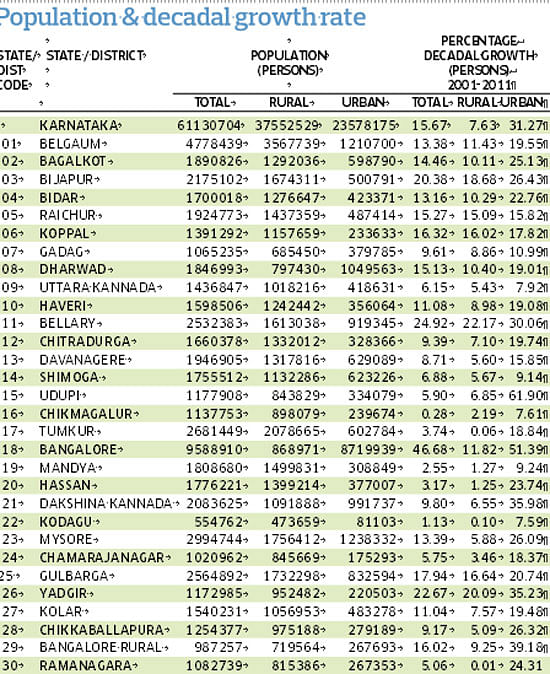
Of the 6.11 crore population in Karnataka, 61.43 per cent live in rural areas, but their number has drastically declined since the last Census, giving an indication of the increased preference of the people to shift to cities.
According to the Census of India’s 2011 Provisional Population Totals of Rural-Urban Distribution (district-wise) data released on Friday, the level of urbanisation in Karnataka increased from 33.99 per cent in the 2001 Census to 38.57 per cent in 2011, while the proportion of rural population declined from 66.01 per cent to 61.43 per cent.
In absolute terms, while 3.75 crore of the State population live in rural surroundings, 2.35 crore people reside in cities and towns.
Anil Kumar, Director of Census Operation, Karnataka, said the data released on Friday provides a district-wise picture of urban and rural distribution of the population. Data on population of cities and towns would be released by July-end, he said.
The statistics reveal that while the maximum number of people living in rural areas in a particular district in the State is 35.6 lakh in Belgaum, the metropolis of Bangalore tops the list of the maximum number of people in urban areas at 87.1 lakh.
Districts where the urban population has crossed the 10 lakh-mark include Belgaum (12.1 lakh), Dharwad (10.4 lakh) and Mysore (12.3 lakh)
The mine-rich Bellary district has clocked a high growth in urban areas (24.92 pc) followed by Yadgir (22.67 pc) and Bijapur (20.38 pc), indicating the increased urbanisation in these districts.
As per the overall provisional census -2011 released in April, Chikmagalur was the lone district that recorded a negative decadal growth. A different picture emerges when urban-rural distribution is considered.
As many as five districts have clocked negative growth in rural pockets — Chikmagalur, Udupi, Hassan, Ramanagara and Dakshina Kannada — revealing migration of rural population to urban pockets has played a major role in overall population growth in these districts. The data shows there is an increase in the overall sex ratio in the State from 965 in 2001 to 968 in 2011. However, the improvement in the overall sex ratio is largely in urban areas.
Bangalore Rural
According to the report, the sex ratio discrepancy is glaring in Bangalore Rural, which has 872 females to 1,000 males.
Nine districts have higher sex ratio in rural areas and they are Bidar, Raichur, Udupi, Tumkur, Kodagu, Gulbarga, Yadgir and Ramanagara.
The fall in the growth of population of children (0-6 years), as revealed in the overall provisional census, is due to the steep decline of 11 per cent in rural areas. In urban pockets, the child population increased by 11 per cent.
The improvement in the literacy rate in rural areas is considerable. The rural-urban literacy gap, which was 21.25 percentage points in 2001, has come down to 17.35 percentage points in 2011. There is more improvement in female literacy than in male literacy in both rural and urban areas, according to the latest census.
The gender gap in literacy has come down from 22.44 in 2001 to 18.32 in 2011 in rural areas and from 12.54 in 2001 to 8.83 in 2011 in urban areas.
Highlights
* 3.75 crore people live in rural areas
while 2.35 crore people reside in cities
and towns.
* There has been increase in he growth of population in urban areas at the
expense of rural pockets.
* Belgaum district has the maximum number of people living in rural areas (35.6 lakh)
* Bangalore has the maximum number of people living in urban
areas at 87.1 lakh.
* Improvement in the overall sex ratio is largely in urban areas.
* Steep decline of 11 per cent in children population
in rural areas.
* Rural areas record considerable improvement in literacy rate.